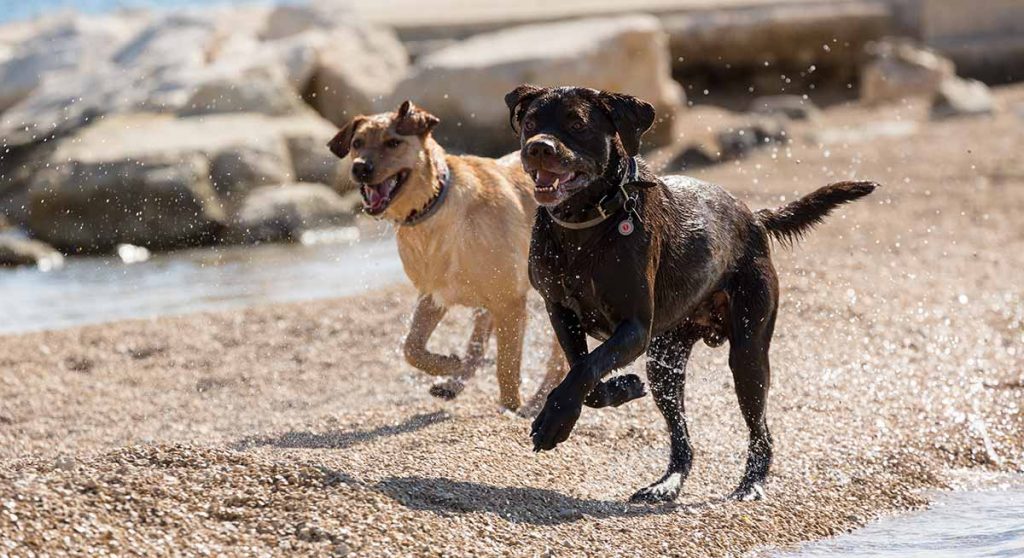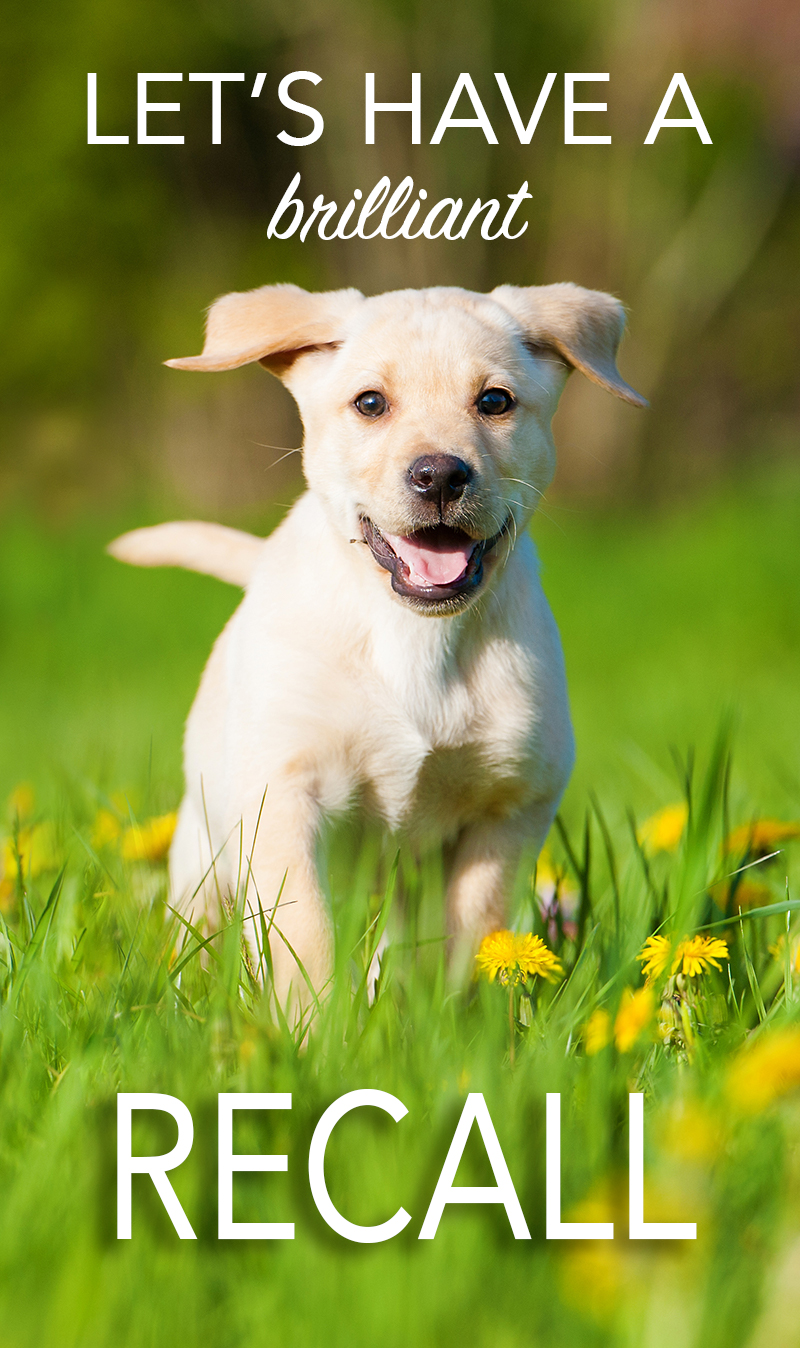Dog Recall – Get A Great Recall With Our Training Tips And Guides
The perfect dog recall response will have your dog running to your side the moment you pip your whistle or call their name. They will come when you call wherever you are, whatever they are doing and whomever else is nearby.

Getting a perfect recall is every dog owner’s dream, but dog recall training can be challenging. You need to teach the dog exactly what you want them to do when you call them. And then teach them that this cue should elicit the same response regardless of any other environmental factors. And that’s where most people fall short.
- Why recall training matters.
- Dog recall training with distractions.
- Top dog recall training tips.
- Help with puppy recall training.
We have so many resources on this website dedicated to helping you with your dog recall training. Here you’ll find all the information and advice you need to teach your dog a really reliable recall, together with some great tips for a successful puppy recall too.
Training instructions, video, and articles, it’s all here! You can also get Pippa’s Training Tips delivered directly to your inbox. Just drop your email in the box below.
[thrive_leads id=’27481′]
Dog Recall Is The Most Important Command
Dog recall is a final safety net. A way to get your dog instantly out of dangerous situations, from cliff edges to road sides and even out of the clutches of potential dognappers!
We all love the sight of our dog bounding back towards us. Not only is a dog that comes when called a great pleasure, recall is a critically important response in all dogs, and can literally save lives.
Ignoring the recall, selective deafness, and running away, are common problems in dogs. But don’t worry, help is at hand.
Why is Dog Recall Training Hard?
Dog recall training is hard because dogs are easily distracted and teaching a dog to obey among distractions is a skill that many people lack.
It is hard because successful recall training requires effective use of rewards. And it’s also hard because distraction training is more difficult when the dog is further away, and of course with recall, your dog by definition is never close to you.
Fortunately all these challenges can be overcome!
What you need to do is
- Learn how to train with distractions
- Learn how to use rewards effectively
- Follow a well constructed recall training programme
These three factors are what separate people whose dogs have a great recall, from people whose dogs won’t come when they are called. Let’s take a closer look.
Dog Recall Training with Distractions
Calling your dog across the kitchen may be a breeze. Calling him in from the yard when he’s enjoying watching the birds in your hedge, or barking at passers-by is a little more challenging.
And calling your dog at the park when he’s wrestling with his favorite playmate, may be a step too far.
Life is full of distractions but you can teach your dog to ignore them by introducing carefully in a structured way. This is a part of any effective dog training course and it’s known as proofing.
Using rewards effectively
Knowing how and when to reward your dog is critical. Poorly used, rewards can become a bribe. And you can end up with a dog that ignores you unless you are holding out a hot dog.
Using rewards in dog training requires a little knowledge and understanding.
The links in this article will help you. Once you start to follow an effective training program it will all fall into place.
 Dog Recall Tips, Advice And Training Guides
Dog Recall Tips, Advice And Training Guides
The reading material you need and the training program for you to follow is all contained in the following two guides – and you need to read them in this order
You might also like
- How to keep your dog close on walks
- How to get a really reliable recall
- Losing control of your dog?
- How to correct a dog that ignores the recall
You’ll find lots more information in Pippa’s Training Tips emails.
[thrive_leads id=’27481′]
Of course, there is no better way to get a great recall than to get off to a great start with your puppy.
Puppy Recall Training Tips
Getting your recall training off to a good start is really important. But it can be a scary moment letting your new puppy off the lead for the very first time.
Puppyhood is the right time to start an you can establish a great recall with your Labrador puppy if you follow a few key rules.
Here are the important ones:
- Protect your signal
- Call when he is coming
- Use a marker
- Use BIG rewards
- Say it only once
#tip 1: Protect your recall signal
This is the most important of all puppy recall rules.
If you use your recall word (come or here for example) or whistle, and the puppy does something other than come rushing straight to you, then you have taught the puppy that the word ‘Come’ means absolutely nothing. Zero.
People do this every day, all day, and then wonder why the pup ignores them.
Defend your recall word. Don’t use it unless you can guarantee 100% that the pup will come to you.
And there are only two ways to be certain of that guarantee:
- when the pup is already running towards you
- when the pup is attached to long lead
Which brings us to our next tip.
#tip 2: Call when they are already coming!
Puppies often rush toward people. Your puppy will chase after you if he thinks you are leaving him.
He will run to you when you have food ready for him (supper time) and he will run to you if you make lots of nice encouraging squeaky noises or when you get down on the floor to his level.
These are all opportunities to use your recall word with guaranteed success. But wait until he is actually on his way, running towards you, to give the command.
#tip 3: Use a marker
Use an event marker. An event marker is a signal (usually a sound) that tells the puppy he is about to get a reward.
It’s called an event marker because it can be used to mark any event in your puppy’s life, including the things he does. Like looking at you, or running towards you.
A marker is helpful because it gives the puppy feedback at the exact point in time when he did what you want.
For example, a puppy might start towards you, then get distracted and change his mind. If you use a marker, such as a clicker for example, you can give him a signal as he starts towards you, which lets him know that a) you love it when he moves towards you, and b) he is about to get a reward.
This is a huge incentive for him to come all the way to your side.
#tip 4: Use BIG Rewards
We are not talking about the physical size of the reward here, you don’t need to carry a 10lb bag of treats around with you. We are talking about big value. Specifically what is valuable to your dog. Not to you.
Here are the most exciting rewards for a young puppy.
The best rewards are often
- Edible
- Moist/juicy
- Strong flavoured or smelling
Another great reward for very small pups is just to be cuddled by you and to feel safe.
However, later on when he gets interesting in hunting and chasing stuff, you may find it helpful if he is used to working with food, so I suggest you use some food rewards too, right from the start.
A few dog trainers don’t like to use food rewards. You can find out why, and read more about training with food rewards here: Training with treats
#tip 5: Say it only once
Repeating commands devalues them and teaches the dog to ignore the command in the future.
Only ever use a command once.
Get that puppy rushing towards you by any other means, but only use that precious recall command one time only.
That way the puppy will learn to always respond to a single command and you will never need to repeat it.
More information
If you’d like to read Pippa’s full length, best selling recall training book, it’s called Total Recall.
You can buy Total Recall from Amazon by following this link(paid link). If you do, The Labrador Site will receive a small commission which is greatly appreciated and won’t affect the cost to you!
And it’s packed with clear, no-nonsense advice and step-by-step training instructions.
We hope you find the articles and video helpful, and don’t forget, you can always drop into Pippa’s Forum for a chat and some support from many experienced Labrador owners.

Free Labrador Updates!
Get my training tips, news, reviews, and the latest from The Labrador Site delivered to your inbox

 Dog Recall Tips, Advice And Training Guides
Dog Recall Tips, Advice And Training Guides

Hi Pippa!
Really appreciate all of the advice you give on this site! I was wondering, should I say my dog’s name as he is running towards me, to make his name (Teddy) the recall signal? Or will this confuse my pup later? Wondering if it’s wiser to go with “come here” or a whistle
Hoping you see this and can provide some awesome feedback! Thanks!
Hi JD, we recommend you don’t use Teddy’s name as his recall cue, because people will tend to say his name at other times, when he’s not running towards you, too. And this can ‘poison’ the recall cue. Instead we suggest picking a word that people won’t tend to say, or better still using a whistle cue, as his recall cue. Sammie 🙂
I just bought my 8 month old pit-lab mix a long line to help work on off leash training. is there anyway to get him to “come” a little more reliably?
what do you recommend for a 2 year old speyed animal that has learned everything and choses her responses. i.e cannot be relied upon to act predictably.
Thank you so much for this article .